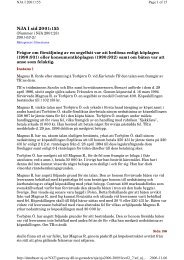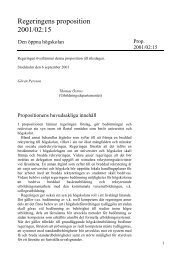A Study of the ITU-T G.729 Speech Coding Algorithm ...
A Study of the ITU-T G.729 Speech Coding Algorithm ...
A Study of the ITU-T G.729 Speech Coding Algorithm ...
You also want an ePaper? Increase the reach of your titles
YUMPU automatically turns print PDFs into web optimized ePapers that Google loves.
Open<br />
MASTER THESIS<br />
Datum - Date Rev Dokumentnr - Document no.<br />
04-09-28 PA1<br />
In <strong>the</strong> spectral envelope for voiced speech, <strong>the</strong> formants can be identified as peaks.<br />
The phoneme /ih/ has formants at approximately 300, 2300 and 3000 Hz. The formant’s<br />
bandwidth describes <strong>the</strong> width <strong>of</strong> <strong>the</strong> formants peaks. Formants and <strong>the</strong>ir bandwidths<br />
are <strong>the</strong> most important spectral features. They characterize <strong>the</strong> sounds <strong>of</strong> a speaker. In<br />
Figure 6: Waveforms and spectrums, for <strong>the</strong> voiced sound /ih/ and <strong>the</strong> unvoiced /s/.<br />
The dashed line in <strong>the</strong> spectrum shows <strong>the</strong> LPC envelope.<br />
statistical terms, a speech signal may be classified as a non-stationary random process.<br />
It is commonly assumed that a speech signal is wide sense stationary and ergodic in<br />
autocorrelation for short-time periods from 10 to 30 ms.<br />
The autocorrelation for a discrete-time deterministic signal is given by<br />
Rxx =<br />
∞<br />
m=−∞<br />
x[m]x[m + k] (1)<br />
The Discrete Fourier Transform (DFT) <strong>of</strong> <strong>the</strong> autocorrelation function yields <strong>the</strong> power spectrum<br />
<strong>of</strong> <strong>the</strong> signal, according to <strong>the</strong> equation<br />
Sxx ∆ =<br />
∞<br />
n=−∞<br />
Rxx(n)e −jωn<br />
This shows that <strong>the</strong> short-term autocorrelation for a frame is a function <strong>of</strong> <strong>the</strong> power spectral<br />
envelope, which in turn is directly related to <strong>the</strong> shape <strong>of</strong> <strong>the</strong> vocal tract. Thus, <strong>the</strong><br />
short-term autocorrelation is a function <strong>of</strong> <strong>the</strong> shape <strong>of</strong> <strong>the</strong> vocal tract.<br />
(2)<br />
20 (78)





